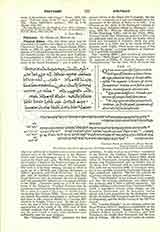

Polyglot Bibles.—The first Bible which may be considered a Polyglot is that edited at Altar. (in Latin Complutum, hence the name Complutensian Bible), Spain, in 1502-17, under the supervision and at the expense of Cardinal Ximenes, by scholars of the university founded in that city by the same great Cardinal. It was published in 1520, with the sanction of Leo X. Ximenes wished, he writes, “to revive the languishing study of the Sacred Scriptures”-; and to achieve this object he undertook to furnish students with accurate printed texts of the Old Testament in the Hebrew, Greek, and Latin languages, and of the New Testament in the Greek and Latin. His Bible contains also the Chaldaic Targum of the Pentateuch and an inter-linear Latin translation of the Greek Old Testament. The work is in six large volumes, the last of which is made up of a. Hebrew and Chaldaic dictionary, a Hebrew grammar, and Greek dictionary. It is said that only six hundred copies were issued; but they found their way into the principal libraries of Europe and had considerable influence on subsequent editions of the Bible. Vigouroux made use of it in the very latest of the Polyglots. Cardinal Ximenes was, he assures us, eager to secure the best manuscripts accessible to serve as a basis of his texts; he thanks Leo X for lending him Vatican MSS. Traces of such MSS. are, indeed, discernible, particularly in the Greek text; and there is still a copy at Madrid of a Venetian MS. which he is thought to have used, He did not, however, use any of what are now considered the best; appreciation of the worth of the MSS., and of their variant readings, had still much progress to make; but the active work of many years produced texts sufficiently pure for most purposes.
The “Complutensian Bible” published the first printed edition of the Greek Old Testament, the one which was commonly used and reproduced before the appearance of the edition of Sixtus V, in 1587. It is followed, on the whole, in the Septuagint columns of the four great Polyglots edited by Montanus (Antwerp, 1569-72); Bertram (Heidelberg, 1586-1616); Wolder (Hamburg, 1596); and Le Jay (Paris, 1645). Ximenes’ Greek New Testament, printed in 1614, was not published until six years after the hastily edited Greek New Testament of Erasmus, which was published before it in 1516; but in the fourth edition of Erasmus’ work (1527), which forms the basis of the “Textus Receptus”, a strong influence of Ximenes’ text is generally recognized.
The “Antwerp Bible“, just mentioned, sometimes called the “Biblia Regia”, because it was issued under the auspices of Philip II, depends largely on the “Complutensian” for the texts which the latter had published. It adds to them an interlinear translation of the Hebrew, the Chaldaic Targums (with Latin translation) of the books of the Hebrew Bible which follow the Pentateuch, excepting Daniel, Esdras, Nehernias, and Paralipomenon, and the Peshito text of the Syriac New Testament with its Latin translation. This work was not based on MSS. of very great value; but it was carefully printed by Christophe Plantin, in eight magnificent volumes. The last two contain an apparatus criticus, lexicons and grammatical notes.
The “Paris Polyglot” in ten volumes, more magnificent than its Antwerp predecessor, was edited with less accuracy, and it lacks a critical apparatus. Its notable additions to the texts of the “Antwerp Bible“, which it reproduces without much change, are the Samaritan Pentateuch and its Samaritan version edited with Latin translation by the Oratorian, Jean Morin, the Syriac Old Testament and New Testament Antilegomena, and the Arabic version of the Old Testament.
The “London Polyglot” in six volumes, edited by Brian Walton (1654-7), improved considerably on the texts of its predecessors. Besides them, it has the Ethiopic Psalter, Canticle of Canticles, and New Testament, the Arabic New Testament, and the Gospels in Persian. All the texts not Latin are accompanied by Latin translations, and all, sometimes nine in number, are arranged side by side or one over another on the two pages open before the reader. Two companion volumes, the “Lexicon Heptaglotton” of Edmund Cassel, appeared in 1669. The Bible was also published in several languages by Elias flutter (Nuremberg, 1599-1602), and by Christianus Reineccius (Leipsic, 1713-51).
Modern Polyglots are much less imposing in appearance than those of the sixteenth and seventeenth centuries; and there is none which gives the latest results of scientific textual criticism as fully as did Brian Walton‘s in its day. We may cite, however, as good and quite accessible:—Bagster, “Polyglot Bible in eight languages” (2 vols., London, 2nd ed. 1874). The languages are Hebrew, Greek, English, Latin, German, Italian, French, and Spanish. It gives in appendix the Syriac New Testament, the Samaritan Pentateuch, and many variants of the Greek text. This Bible is printed in very small type. It is a new edition, on a reduced scale, of Bagster’s “Biblia Sacra Polyglotta” (6 vols., London, 1831). “Polyglotten-Bibel zum praktischen Handgebrauch”, by Stier and Theile, in four quarto volumes (5th ed., Bielefeld, 1890). This Polyglot contains the Hebrew, Greek, Latin, and German texts. “Biblia Triglotta”, 2 vols., being, with the omission of modern languages, a reissue of the “Biblia Hexaglotta”, edited by de Levante (London, 1874-6). It contains the Hebrew, Greek, and Latin texts of the Old Testament, and the Greek, Latin, and Syriac texts of the New Testament. Published by Dickenson, London, 1890. “La Sainte Bible Polyglotte” (Paris, 1890-98), by F. Vigouroux, S.S., first secretary of the Biblical Commission, is the only modern Polyglot which contains the deuterocanonical books, and the only one issued under Catholic auspices. Vigouroux has secured the correct printing, in convenient quarto volumes, of the ordinary Massoretic text, the Sixtine Septuagint, the Latin Vulgate, and a French translation of the Vulgate by Glaire. Each book of the Bible is preceded by a brief introduction; important variant readings, textual and exegetical notes, and illustrations are given at the foot of the pages.
W. S. REILLY

